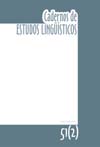Resumo
The concept of genre has become fundamental, particularly for the purposes of teaching reading and written production. In Brazil, this line of research has presented a common focus: the perspective of intervention in education issues, either immediately or prospectively (MACHADO, 2005). This study focuses on the characterization of genres as teaching tools and aims to analyze the sequential organization of abstracts of scientific articles, as proposed in Machado (1996). The theoreticalphilosophical perspectives which guided the study are mainly Bakhtin’s Enunciation Theory (1992; 1997) and the Socio-Discursive Interactionism (BRONCKART, 2003). Based on Adam’s concept of sequence, Machado poses a hypothesis according to which the sequential organization of texts belonging to the critical review genre (which includes articles’ abstracts) would be organized by descriptive sequences, as subtypes of Adam’s Descriptive Sequence. Thus, a number of abstracts were here selected and analyzed in an attempt to identify, in their sequential organization, such subtypes of sequences suggested. The analysis showed that the characterization of these texts’ internal structure fundamentally depends on the acknowledgment of the genre to which they belong. This perception, which recognizes these language actions (texts) as abstracts of scientific articles – texts approximately 300 words-long, published in journals, immediately previous to their articles – generates expectations regarding their internal structure and, only then, it is possible to realize them as texts organized into the subtype: Text-Descriptive Sequence.Referências
BAKHTIN, M; (VOLOCHÍNOV). (1997). Marxismo e filosofia da linguagem. Tradução de Michel Lahud e Yara Frateschi Vieira. São Paulo: Hucitec.
BAKHTIN, M. (1992). Estética da criação verbal. São Paulo: Martins Fontes.
BARBOSA, W. V. (2002). O materialismo histórico. In: REZENDE, A. Curso de filosofia. Rio de Janeiro: Jorge Zahar. p. 173-195.
BAZERMAN, C. (2005). Atos de fala, gêneros textuais e sistemas de atividades: como os textos organizam atividades e pessoas. In: DIONÍSIO, A. P.; HOFFNAGEL, J. C. Gêneros textuais, tipificação e interação. Tradução e adaptação de Judith Chambliss Hoffnagel. São Paulo: Cortez. p. 19-61.
BELCHER, D. D. (2006). English for Specific Purposes: Teaching to perceived needs and imagined futures in worlds of work, study and everyday life. TESOL Quarterly, v. 40, n. 1, p. 133.
BRONCKART, J.-P. (2003). Atividades de linguagem, textos e discursos: por um interacionismo sóciodiscursivo. Tradução de Anna Rachel Machado. São Paulo: EDUC.
HABERMAS, J. (2003). Consciência moral e agir comunicativo. Tradução de Moralbewusstsein und kommunikatives Handeln. Rio de Janeiro: Tempo Brasileiro.
KHODADADY, E. (2004). Schema-Based Cloze Multiple Choice Item Tests: Measures of reduced redundancy and language proficiency. The ESPecialist, São Paulo: PUC, v. 25, n. 2, p. 221.
MACHADO, A. R. (1996). A organização seqüencial da resenha crítica. The ESPecialist, São Paulo: PUC, v. 17, n. 2, p. 133-149.
MACHADO, A. R. (2005a). Revisitando o conceito de resumos. In: DIONÍSIO, A. P.; MACHADO, A. R.; BEZERRA, M. A. Gêneros textuais e ensino. Rio de Janeiro: Lucerna. p. 138-150.
MACHADO, A. R. (2005b). A perspectiva interacionista sócio-discursiva de Bronckart. In: MEURER, J. L.; BONINI, A.; MOTTA-ROTH, D. Gêneros: teorias, métodos, debates. São Paulo: Parábola. p. 237-259.
MAGALHÃES, B. (2006). O sujeito do discurso: um diálogo possível e necessário. Linguagem em discurso, UNISUL, v. 3, número especial, 2003. Disponível em: http://www3.unisul.br/paginas/ensino/pos/linguagem/0303/05.htm. Acesso em: 15 jun.
RAMOS, R. C. G. (2004). Gêneros textuais: uma proposta de aplicação em cursos de inglês para fins específicos. The ESPecialist, São Paulo: PUC, v. 25, n. 2, p. 107.
STELLA, P. R. (2005). Palavra. In: BRAIT, B. Bakhtin: conceitos-chave. São Paulo: Contexto. p. 7790.
SWALES, J. M. (2004). Research genres: exploration and aspiration. Cambridge: CUP .
VYGOTSKY, L. S. (1974). Thought and language. Tradução de Eugenia Hanfmann e Gertrude Vakar. Massachusetts: The MIT Press.
ZANELLA, A.; HEBERLE, V. (2005). Abstract ou summary: um estudo do metadiscurso e da organização textual de resumos acadêmicos na área biomédica. Arquivos Catarinenses de Medicina. v. 34, n. 4, p. 15-22.
ZUENGLER, J.; MILLER, E. R. (2006). Cognitive and Sociocultural Perspectives: two parallel SLA worlds? TESOL Quarterly, v. 40, n. 1, p. 35.
O periódico Cadernos de Estudos Linguísticos utiliza a licença do Creative Commons (CC), preservando assim, a integridade dos artigos em ambiente de acesso aberto.

